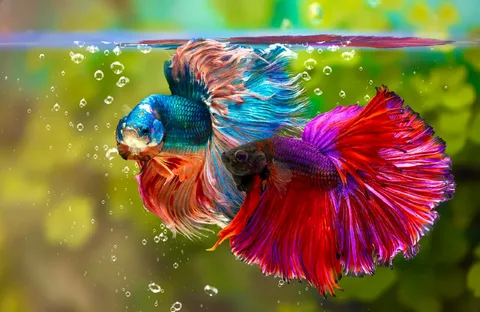Betta fish are territorial and can exhibit aggression, especially towards similar-looking fish. Key behavioral traits include
Territorial Instincts:
Male bettas are particularly territorial and may attack perceived intruders
Aggression Towards Similar Species:
Fish with long fins or bright colors can trigger aggressive responses.
Curiosity:
Bettas are intelligent and enjoy exploring their surroundings.

Ideal Tank Conditions
Creating a suitable environment is essential for peaceful cohabitation
Aquascaping:
Incorporate plants, caves, and decorations to provide hiding spots and break lines of sight.
Tank Size:
A minimum of 10 gallons is recommended for a community tank.
Compatible Tank Mates
Corydoras Catfish
Behavior: Peaceful bottom dwellers that scavenge for food.
Group Size: 4–6 individuals.
Tank Size: 10+ gallons.
Compatibility: They occupy different tank levels, reducing conflict with bettas.
How can I reduce aggression in a betta fish community tank?
Provide ample hiding spots with plants and decorations.
Avoid tank mates with long, flowing fins or bright colors.
Ensure the tank is spacious to minimise territorial behaviour.
Introduce tank mates before the betta when possible.

Kuhli Loaches
Group Size: 5+ individuals.
Tank Size: 20+ gallons.
Harlequin Rasboras Behavior
Behavior: Peaceful schooling fish.
Tank Size: 10+ gallons.
Group Size: 6+ individuals.
Compatibility: Their subdued colours and schooling nature make them less likely to provoke aggression
Neon Tetras Behaviour
Behavior: Small, peaceful fish that prefer to school.
Tank Size: 15+ gallons.
Group Size: 6+ individuals.
Compatibility: Their fast swimming can help them avoid aggressive bettas, but caution is advised.
Ember Tetras
Behavior: Very peaceful and small.
Tank Size: 10+ gallons.
Group Size: 6–10 individuals.
Compatibility: Their small size and non-threatening appearance make them suitable companions.

Otocinclus Catfish Behaviour
Behavior: Peaceful algae-eaters.
Tank Size: 10+ gallons.
Group Size: 3–6 individuals.
Compatibility: They help keep the tank clean and stay out of the betta’s way.
Mystery Snails
Behaviour: Non-aggressive invertebrates.
Tank Size: 5+ gallons.
Compatibility: Their hard shells provide protection, and they assist in cleaning algae.
Tank Mates to Avoid
Due to their aggressive nature or similar appearance, certain species are incompatible with bettas:
Male Guppies: Their bright colors and flowing fins can trigger aggression.
Tiger Barbs: Known for fin behavior
Other Male Bettas: High risk of fighting.
Gouramis: Similar in appearance and behaviour, leading to potential conflicts.
Female Betta fish Sororities
Female betta fish can sometimes coexist in groups, known as sororities.
Tank Size: 20 gallons.
Group Size: 4–6 females.
Environment: a lot of vegetation and a lot of hiding places.
Monitoring and Maintenance
Regular observation is key to a harmonious tank.:
Signs of Stress or Aggression:
- Torn fins
- Hiding or lethargy
- Loss of appetite
- Color fading
Feeding: Ensure all species receive appropriate nutrition.
Backup Plan: Have a separate tank or divider ready in case separation is needed.
Tips for Success in a Betta Community Tank
Add the Betta Last: Add the other fish first. Let them establish their territories. Add the betta a few days later to reduce territoriality.
Feed Appropriately: Ensure everyone is given the proper food. Bettas are given floating pellets, and bottom dwellers are given sinking wafers.
Maintain a Spare Tank: A spare or quarantine tank is handy in the event of aggression or sickness.
Watch Closely: Particularly the first week. All bettas are a little unique as far as temperament goes. Some are calm; some are lone wolves.
Conclusion
While betta fish are solitary by nature, with proper planning and attention, some species can be kept with them. Understanding their nature, introducing an appropriate environment, and selecting compatible tankmates are the rudimentary steps in creating a peaceful and colorful aquarium.
While betta fish are territorial as well, they can be kept with some tank mates peacefully if careful planning and care are employed. With the right species, sufficient space, and perfect water conditions, you can enjoy a peaceful and colorful aquarium community. But always watch your betta’s attitude when introducing new companions, since each has its personality
FAQs
Can male betta fish live with other male betta fish?
No, male betta fish are very territorial and will fight if housed together and can inflict serious injury or be deadly.
Can female betta fish live together?
Yes, occasionally females can be kept in groups called “sororities.” But this must be done cautiously, like a tank of 20 gallons or larger, with plenty of hiding places and careful observation for fighting.
What are some suitable tank mates for betta fish?
Compatible tank mates include peaceful, non-aggressive species such as:
Corydoras catfish
Kuhli loaches
Harlequin rasboras
Neon and ember tetras
Otocinclus catfish
Mystery and nerite snails
Amano and ghost shrimp
African dwarf frogs
Are there any fish to avoid keeping with bettas?
Yes, avoid housing bettas with:
Other male bettas
Tiger barbs
Gouramis
Chinese algae eaters
Fancy guppies
Goldfish. This species may provoke aggression or have incompatible environmental needs.
How can I introduce new tank mates to my betta?
Ensure the tank is spacious and well-decorated with hiding spots.
Introduce new tank mates gradually, monitoring for signs of aggression.
Consider adding the betta last to reduce territorial behaviour.
Be prepared to separate fish if conflicts arise.
What signs indicate incompatibility between bettas and tank mates?
Chasing or nipping
Torn fins
Hiding or stress behaviors
Loss of appetite
Can bettas live with shrimp or snails?
Yes, bettas are generally compatible with shrimp and snails. Betta personalities can differ, though, so watch interactions closely.
What tank size is recommended for a betta community tank?
A minimum of 10 gallons is recommended for a betta and some tankmates that are suitable. The bigger tanks provide more room and fewer territorial battles.










